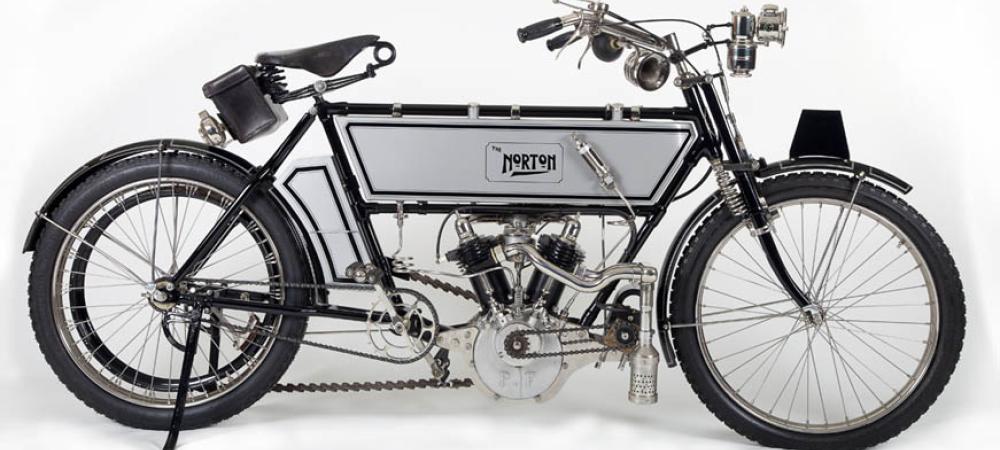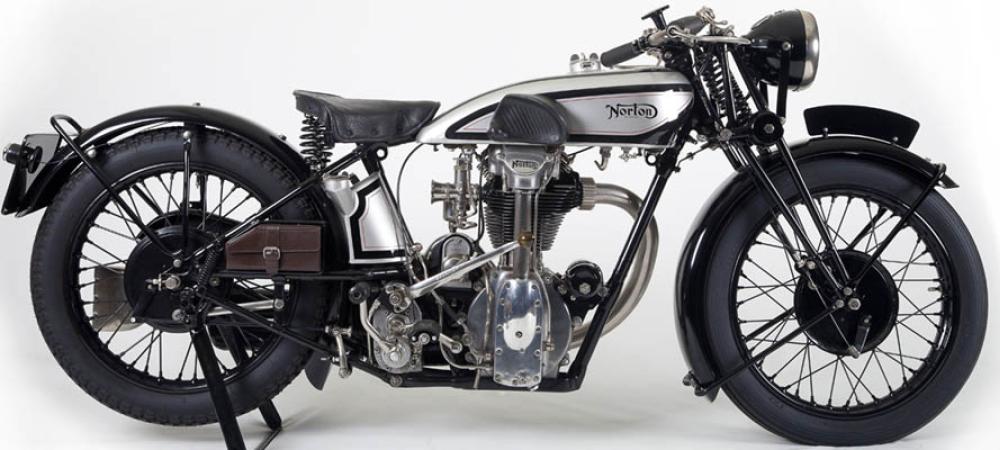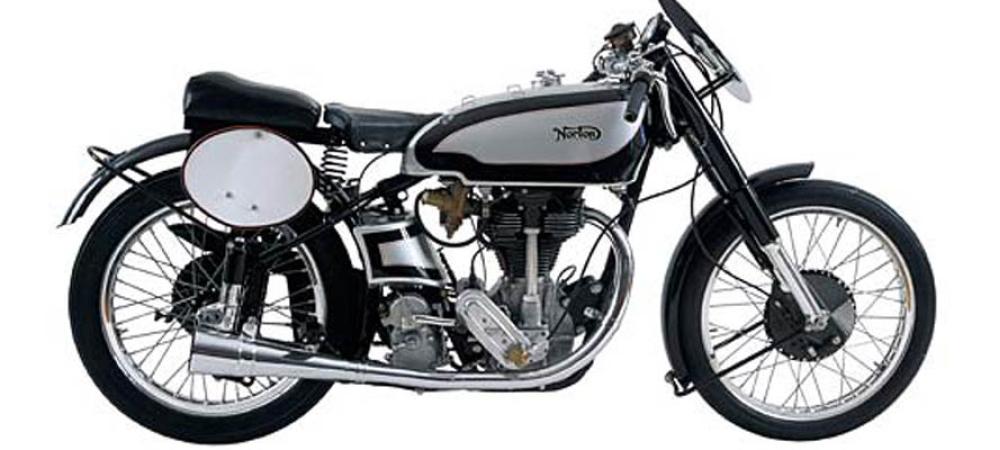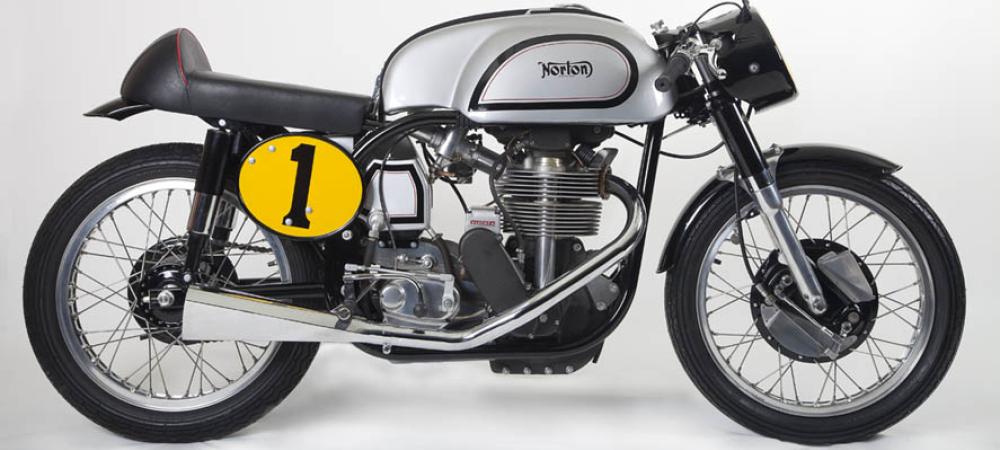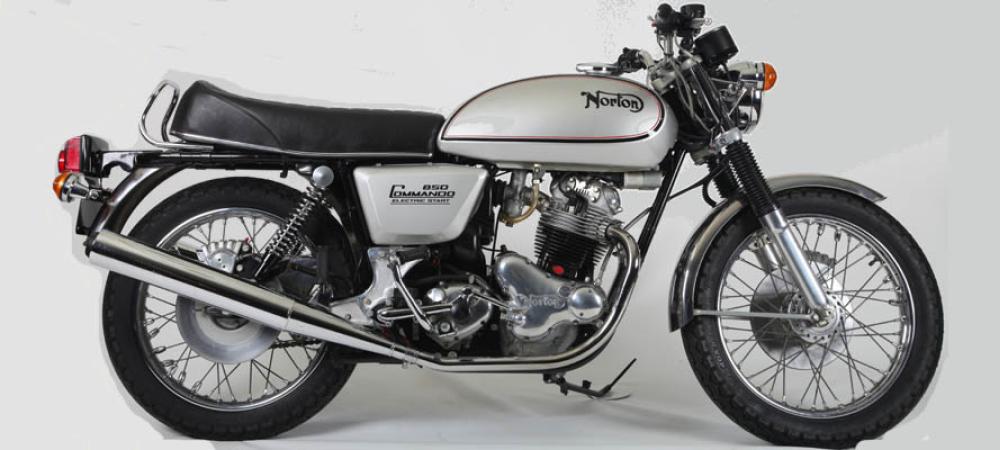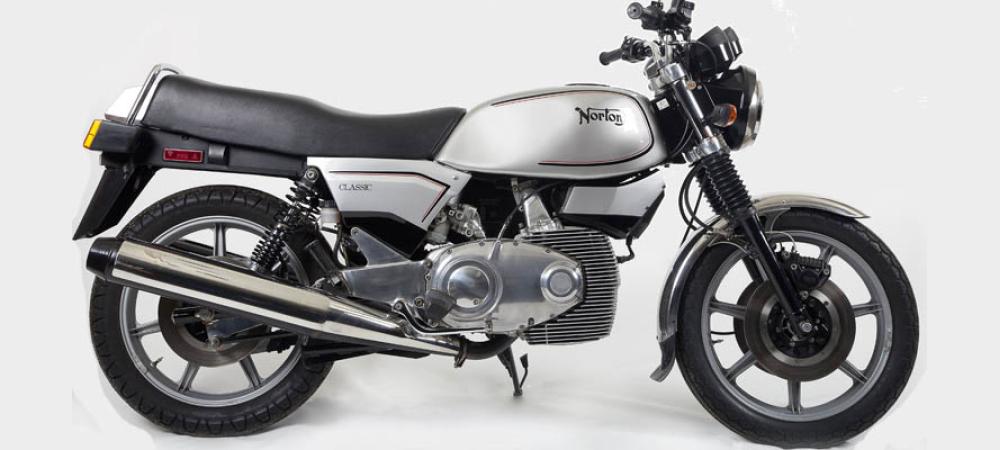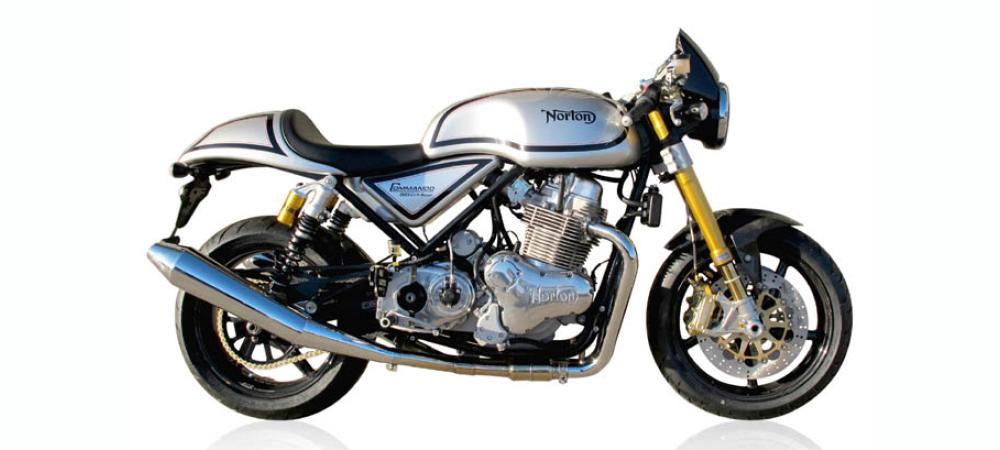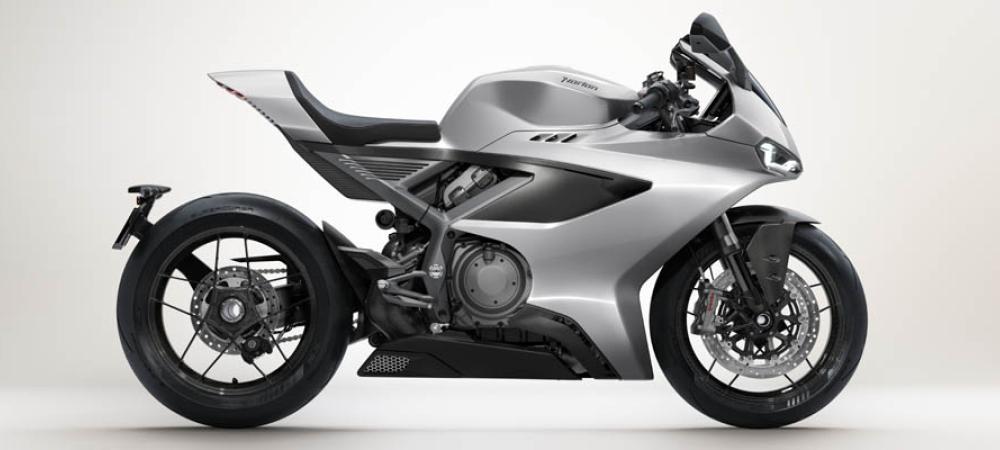DOMINATOR
From Model 7 to Mercury
The basic span of the humble 500cc to 828cc Norton twin engine design was from 1947 to 1976. Power output varied from 29 b.h.p. to 60 b.h.p. in production forms, A third place in the 1961 Senior TT, first in the 1973 Formula 750 TT and 139 mph as a dragster are just some of the feats this engine has achieved and it has also been the basis of some twenty models of Norton through to the last Commando. I hope in these few notes to cover part of the history of the Norton marque, but this time only dealing with the twin cylinder engine and its production changes.
1947/48
Bert Hopwood left Triumph in 1947 in order to join Norton as Chief Designer and the opportunity to design his own vertical twin engine without the drawbacks of the Triumph, i.e. overheating and rattling. The former was overcome on the new engine by incorporating splayed exhaust ports so allowing more air flow over the particularly hot areas, while the rattling was supposedly reduced by the use of a single camshaft driven by a chain. Old machine tools and old ideas stopped him from producing a one piece crankshaft so a strong three part one was designed with careful attention to detail so as not to copy the Triumph crank. The original capacity of 497cc was achieved by a bore and stroke of 66 x 72.6mm. Both inlet and exhaust valves were of the same size at 1.29", compression ratio was 6.7:1. The cylinder head was of cast iron with an integral single carburettor manifold and equipped with a 1" Type 76 Amal carburettor. Ignition was courtesy of the ubiquitous Joe Lucas magneto. The machine was first seen at the 1948 Earls Court Show and given the designation Dominator Model 7. The top speed of the new bike was 92 mph, which was quite good for the day, along with a fuel consumption figure of over 50 mpg even if driven hard. The cast in carburettor manifold was soon replaced by an alloy bolt on unit. The layout of just about every part of this engine was to remain unaltered right through to the end in 1976, camshaft bushes, drive chain and half time gear, oil pump, main bearings, drive side roller and timing side ball race, three piece crank, handed pistons, rockers and their shafts can all be readily recognised for their origins even if detail changes render the parts not directly interchangeable.
1952
The first few years saw the engine in the single down tube frame, but in 1952 it was rehoused in the new Featherbed frame and it thus became known as the Model 88, though this was not marked by any significant changes to the engine. The new frame was claimed to be some 30 pounds lighter though there doesn't seem to have been any corresponding improvement in top speed, but acceleration was better.
1954
An alloy cylinder head was fitted to the Model 88 although it had been first used experimentally in 1950 on the ISDT works twins. The compression ratio was now 6.8:1 and the carburettor an Amal 376, still of 1" bore. The brake horse power became quoted as 29.5 with the limit now taken from 6000 rpm to 7000.
1956
The year 1956 seemed to be the year of many changes; the Model 7 was dropped, but for the 88 a new higher compression cylinder head was brought out giving 7.8:1 . A bore and stroke job was also done, the new dimensions being 68 by 82mm to give a capacity of 596cc with a compression ratio of 7.4:1. The new machine was called the Model 99. A performance camshaft known as the Daytona appeared on both engines, while the 99 had an Amal 376 of 1.1/16". The b.h.p. for the 99 was put at 31, at a recommended rev limit of 5750 rpm. Then came a short lived Model 7 the Model 77, this used the single down the tube frame of the Model 7 but with the 596cc engine. Ostensibly this machine was for sidecar use but it didn't sell so it almost disappeared in 1958, but not quite; it was reincarnated as the Nomad. This was an American styled street scrambler with the 600cc engine producing some 36 b.h.p. at 6000 rpm using twin carbs of 1.1/16" and a compression ratio of 9:1. It was for export only of course. The 99, a big brother to the 88, was tested at this time to have a top speed of just over 100 mph.
1957
The problem of heat dissipation again reared its ugly head around this time with all the extra power on tap, there were additional fins between the exhaust ports added to combat this. New pushrods were introduced with steel end caps.
1958
The major alterations in 1958 were in the electrical department, the magneto and dynamo giving way to coil, distributor and an alternator. All this was frowned on by the sporty fraternity of the time, but I do not see that this altered the power from the engine in any way, the drag from the alternator and the longer crankshaft being offset by the lack of the dynamo and its drive gear. The oil pressure relief valve was repositioned inside the timing cover at this time. There is mention of an improved camshaft being used in 1958/59 with quietening ramps that gave a small power boost, while larger inlet and exhaust valves were fitted with stellite tips. As the Nomad had been fitted with twin carburettors and a higher compression ratio there arose a demand for this on the home market. To cater for this, twin carburettors of the same size as the single carburettor fitted to a splayed manifold were now available on both the 88 and 99, along with 9:1 and 8.2:1 compression ratios. This all gave up to a 10% increase in power. Yet more fins were added to the cylinder head.
1959/61
The following year, 1959, seems to have been a quiet year, as was the first part of 1960, but things were hatching so that by the end of 1960 and into 1961, big changes were taking place. The 'slimline' Featherbed frame arrived to replace the 'wideline' on all big twin models and the 88 and 99 appeared in Sports Special form. The SS spec was achieved by twin carburettors, 1" on the 88 and 1.1/16" on the 99, polished ports, and a high performance camshaft. The optional siamese exhaust system also possibly giving a power boost at certain revs, while the compression ratios were many and various - 8:1 on the 1960 88; 8.5:1 on the 1961 version; 1960 Model 99 7.6:1, and 8.25:1 on the 1961 version. The performance of the 99SS was now quoted as capable of over the magic 100 mph, obviously aided by the power now being up at 44 b.h.p. at 6750 r.p.m. with the 88SS 36 b.h.p. at 7000 r.p.m. One 88SS managed to reach 111 mph on the M.I.R.A. test track near Hinckley. But all this activity in 1961 was overshadowed by two items. Firstly, the Australian rider Tom Phillis raced a developed 500cc Domiracer in the 1961 Senior TT and scored a very creditable third place behind Mike Hailwood and Bob Mclntyre both on Manx Nortons after the MV Agusta of Gary Hocking had dropped out. Bearing in mind that this was the first outing for the twin in major competition it was a very fine start and even recorded a lap of 100.3 m.p.h. Those were the days when the TT really meant something and the 100 mph lap was no mean feat. The second item of consequence was the appearance of a 650cc engine, again for the foreign market at first, the USA got the all polychromatic blue Manxman with of course high handlebars etc., plus a reversion back to the magneto, though the alternator was retained, but still at 6 volts. The 647cc was obtained by the use of a new crankshaft with a larger big end giving a stroke of 89mm whilst retaining the 68mm bore. The compression ratio was 8.3:1 and it was equipped with yet another new cylinder head, this time with even more splayed exhaust ports, along with a downdraught inlet tract with two inlet stubs for the twin 1.1/16" Amal Monoblocs. Also included was a rev counter drive box on the timing chest connected to the camshaft, the right hand exhaust pipe being specially bent to avoid fouling by the cable. The alloy push rods gained tapered ends and the double coil valve springs now became multi rate.
1962
The 650 Sports Special was made available to the home market, now with solid skirt pistons, possibly due to "racing improving the breed". It was claimed that the separate exhaust system used gave the most power, the pipes fitted to the downdraught head were always 1.1/4" diameter as opposed to the 1.5/8" of the 88/99, the narrower bore pipe keeping the gas flow speed up and contributing some 3 b.h.p. in the mid to top rev range. The small bore pipes had a sleeve welded on at each end so that the silencer and exhaust port diameters were standardised on all models. The 650 SS was developing 49 b.h.p. at 6800 rpm giving up to 120 mph in very favourable conditions. The same year also saw the last of the Model 99 but this was offset by the introduction of the 88SS complete with downdraught head and magneto. The 650 Standard, which only lasted one year had a single Amal 389 1.1/8" Monobloc carburettor. Both the Domiracer and the Manx terminated in 1962, all the Domiracer stock including 'Low Boy' frames passing to Paul Dunstall who enjoyed much success over the next few years. The factory at Bracebridge Street closed and the remains of a proud marque were transferred to Plumstead under the AMC banner. One other introduction to the Norton name in 1962 was the Atlas, naturally for export only at first and soon to be christened the Mighty Atlas. It was even said to be the fastest motorcycle in production at one time (the Vincent having been out of production for some years). Initially the compression ratio was way down at 7.6:1, brought about by concave pistons and it also started life with a single 1.1/8" carburettor. This all kept the power down to the same as the 650 SS - 49 b.h.p. at 6800 r.p.m. The increased capacity this time came from a bore change to 73mm whilst retaining the 89mm stroke of the 650. In fact the crank was the same on both machines except for some extra machining to the flywheels so that the pistons wouldn't touch it at bottom dead centre, this means that Atlas cranks can be used on the 650. The larger bore meant that the timed engine breather had to move from behind the left cylinder to directly onto the camshaft bulge in the left case. The cylinder head was similar to that fitted to the 650 SS but is not interchangeable either way. All that beefy torque from the 750 had its drawbacks, vibration was so severe it started breaking the front frame lugs, though reversing the tails on these effected a cure. The initial work on the Atlas design was by Doug Hele, further developed by Charles Udall (late of Velocette) and Wally Wyatt of the parent company, AMC. This ownership of the Norton name explains why the 750 engine was to appear in quite a few odd disguises in AMC frames from 1963 onward. Nothing significant happened with the engine on these hybrid machines except for the fitting of twin carburettors, mostly 1.1/8" bore.
1964
There were some significant changes to the electrics in 1964 with the long overdue switch to 12 volts with alternator and zener diode. The magneto was still in use on the 650 SS and Atlas while the 88SS had coil ignition from 1961 to 1966 except for 1962 when it had a magneto. By now the Atlas was available for the home market, having the same black and silver paint finish as the 650 SS, twin 1.1/8" carburettors and magneto with 12 volt alternator electrics.
1965
As far as the engine was concerned nothing happened in 1965, but all models got a 5/8" by 3/8" rear chain in place of the 5/8" by 1/4" one used previously.
1966
Left and right handed Amal Monoblocs were fitted, so allowing easier adjustments to the right unit. The top spigot of the barrel was removed, probably to simplify production and promote head gasket sales. The corresponding recess in the cylinder head was now no longer machined as it was not needed. Stronger con rods were fitted to the Atlas from engine No. 111920. From engine No. 116372 the con rods had a strategically placed hole drilled in order to squirt oil under pressure onto the cylinder bores. At the same time all models were fitted with a six-start worm drive on the oil pump, supposedly giving double delivery. Along with enlarged oilways, the rockers were now pressure fed from the delivery side of the pump. This extra oil to the top end should have reduced the rattles from there, but it did necessitate the rocker spindles being changed from scrolled ones to plain, otherwise top end oiling became over the 'top'. The 500cc engine in its Model 88SS form was finally dropped from the range to leave just the 650 SS and the Atlas plus a couple of the hybrid machines much beloved by AMC. The same year had other changes for the Norton marque far more significant than any of these though, the AMC company were in dire straits financially and were eventually taken over by Manganese Bronze Holdings under the Chairmanship of Dennis Poore. This change of ownership would eventually lead to the development of the Commando.
1967
The Atlas engine got borrowed again for a Norton/Matchless hybrid labelled the P.11, the only engine change worth noting being a power boost to 52.5 b.h.p. at 6400 r.p.m., this being brought about by the fitting of twin Amal 30mm Concentric carburettors, which also appeared on the genuine Nortons. The timing of the Atlas engine breather was altered along with some minor crankcase modification, the death knell of the magneto was sounded with the introduction of a twin point system in a housing that bolted directly in place of the venerable instrument. A capacitor was also fitted to take out the alternator bumps, so allowing some chance of starting with a flat battery or even without one.
1968
The Norton range of machines was severely reduced in 1968 with the axing of the Atlas, 650 SS and all the hybrids. The Featherbed twin was however to struggle on for a couple of years yet in the guise of the Mercury, which was a 650 with less chrome, some 'old RAC' paint and a single carburettor. The name Mercury had first been used on a Matchless single a few years previously. The Norton Mercury was quite a popular machine despite its short life, rumour had it that it was only produced to use up stockpiles of parts as the Commando was obviously where the future of the Norton name lay. And so came to a close the era of the Dominator engine in the Featherbed frame.
© Norton Owners Club 1991
Originally published in the Norton Owners Club Classic Calendar for 1991

